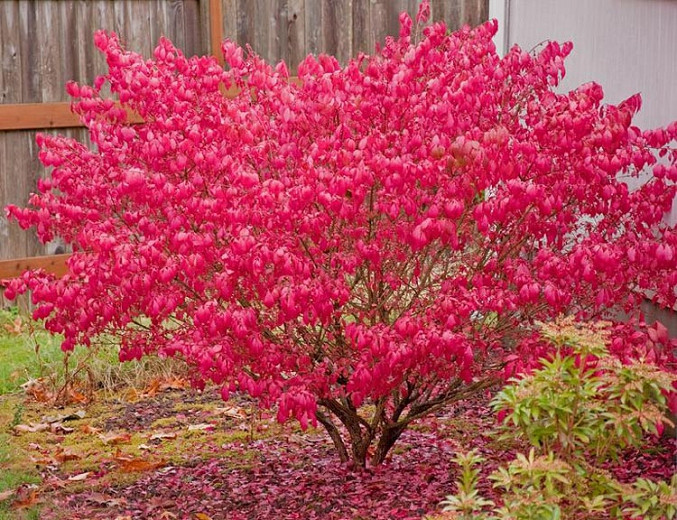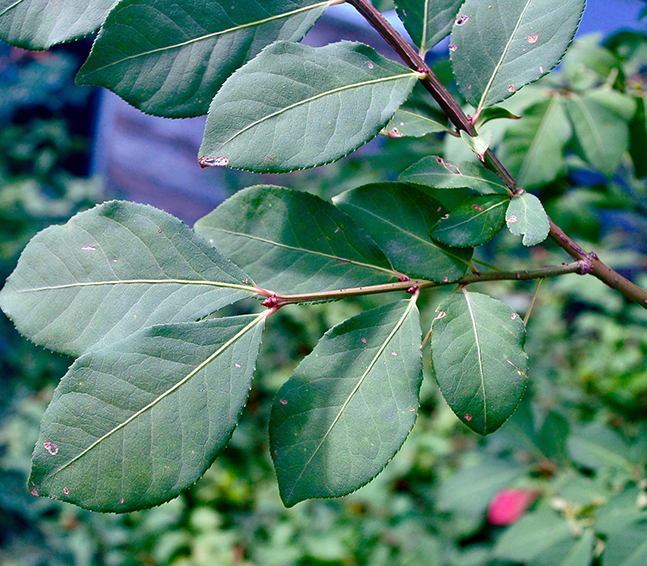Euonymus Alatus: The Burning Bush That's
Euonymus alatus, commonly known as burning bush, is a deciduous shrub native to eastern Asia. It is prized for its bright red fall foliage, which can make a dramatic statement in the landscape. Burning bush is also relatively easy to care for, making it a popular choice for home gardeners.
However, burning bush has one major drawback: it is an invasive species in many parts of the United States. This means that it can quickly spread and displace native plants, which can have a negative impact on the environment.
If you are considering planting burning bush, it is important to weigh the pros and cons carefully. If you live in an area where it is not an invasive species, then burning bush can be a beautiful and low-maintenance addition to your landscape. However, if you live in an area where it is invasive, then you should choose a different plant.
Here are some of the key characteristics of Euonymus alatus:
- Height and spread: Burning bush can grow up to 15 feet tall and 10 feet wide.
- Leaf color: The leaves are green in the spring and summer, and turn bright red in the fall.
- Flowers: The flowers are small and inconspicuous, and they bloom in the spring.
- Fruits: The fruits are small and red, and they ripen in the fall.
- Growing conditions: Burning bush prefers full sun or partial shade, and it can tolerate a variety of soil types.
- Invasive species: Burning bush is an invasive species in many parts of the United States, including the northeastern, midwestern, and southeastern states.
If you are considering planting burning bush, here are some things to keep in mind:
- Burning bush can quickly spread and displace native plants.
- Burning bush can be difficult to control once it is established.
- Burning bush can be toxic to animals and humans.
If you live in an area where burning bush is an invasive species, there are a few things you can do to prevent it from spreading:
- Do not plant burning bush.
- Remove any burning bush plants that you find on your property.
- Do not allow burning bush plants to go to seed.
- If you have burning bush plants on your property, consider surrounding them with a barrier to prevent the seeds from spreading.
If you are concerned about the environmental impact of burning bush, there are a number of other plants that you can choose from that offer similar benefits without the risk of becoming invasive.
Here are a few examples of non-invasive plants that have similar characteristics to burning bush:
- Acer palmatum 'Bloodgood': This Japanese maple has bright red fall foliage.
- Cercis canadensis 'Forest Pansy': This redbud tree has dark purple leaves in the spring and summer, and bright red fall foliage.
- Rhododendron 'Nova Zembla': This rhododendron has dark red flowers in the spring and bright red fall foliage.
By choosing a non-invasive plant, you can help to protect the environment and enjoy the beauty of fall foliage without the risk of introducing an invasive species to your area.
Euonymus alatus, also known as the burning bush, is a deciduous shrub that is native to eastern North America. It is known for its bright red fall foliage and its distinctive corky wings that develop along the stems. Burning bush can grow up to 20 feet tall and wide, making it a popular choice for landscaping. However, it is important to note that burning bush is an invasive species in some parts of the United States.
If you are interested in learning more about euonymus alatus, I recommend visiting the Garden Wiki. This website provides a wealth of information about the plant, including its history, cultivation, and uses. You can also find photos of burning bush in its different stages of growth.
FAQ of euonymus alatus
- What is Euonymus alatus?
- Euonymus alatus, commonly known as burning bush, is a deciduous shrub or small tree that is native to eastern Asia. It is known for its bright red fall foliage and its peeling, orange-red bark. Burning bush is a fast-growing plant that can reach heights of up to 20 feet. It is hardy in USDA zones 4-8.
- Is Euonymus alatus invasive?
- Yes, Euonymus alatus is considered an invasive species in some parts of the United States, including New York, Pennsylvania, and Wisconsin. It is illegal to plant or sell burning bush in some of these states. Burning bush is invasive because it spreads rapidly by seed and root suckers. It can crowd out native plants and alter the natural ecosystem.
- Why is my Euonymus alatus not turning red?
- There are a few reasons why your Euonymus alatus may not be turning red. One possibility is that the plant is not getting enough sunlight. Burning bush needs at least 6 hours of sunlight per day to produce its bright fall foliage. Another possibility is that the plant is not getting enough water. Burning bush needs regular watering, especially during the summer months. Finally, the plant may not be getting enough nutrients. Burning bush can benefit from a balanced fertilizer application in the spring.
- How do I control Euonymus alatus?
- If you have an invasive Euonymus alatus plant, the best way to control it is to remove it. You can dig up the plant and remove all of the roots. You can also cut the plant down to the ground and apply a herbicide to the stump. If you do not want to remove the plant, you can try to contain it by pruning it regularly and removing any seedlings that sprout up.
- What are some alternatives to Euonymus alatus?
- If you are looking for an alternative to Euonymus alatus, there are a few good options. Some popular alternatives include:
- Aronia arbutifolia (chokeberry)
- Cornus sericea (redosier dogwood)
- Physocarpus opulifolius (ninebark)
- Rhus typhina (staghorn sumac)
- Sorbus americana (mountain ash)
- If you are looking for an alternative to Euonymus alatus, there are a few good options. Some popular alternatives include:
Image of euonymus alatus
5 different images of Euonymus alatus I found on Pinterest:
- A burning bush in full fall color. The leaves are a vibrant red, orange, and yellow.

- A close-up of the leaves of a burning bush. The leaves are deeply lobed and have a distinctive winged edge.

- A burning bush in flower. The flowers are small and white, and they bloom in the spring.

- A burning bush in winter. The leaves have fallen off, but the stems are still a vibrant red.

- A burning bush in a landscaped setting. The burning bush is planted in a row with other shrubs and trees.

Post a Comment for "Euonymus Alatus: The Burning Bush That's"